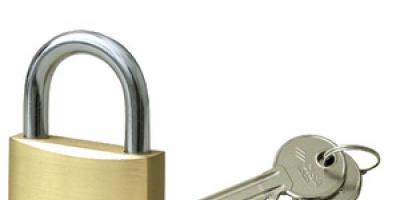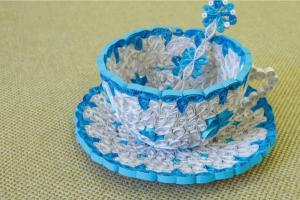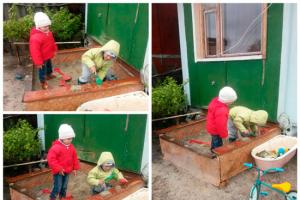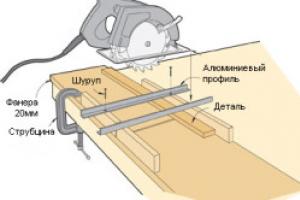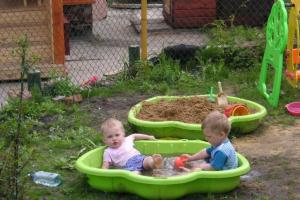The well has long ceased to be the main source of water supply in dachas and rural areas, but still the owners are in no hurry to part with it. After all, in the summer there is a large consumption of liquid for watering the garden, and if you connect the hose to central water supply, then your water bills will increase significantly. And the water in the well is free and always available. True, periodic use of wells leads to deterioration of the water, and at one point the owners discover that it is simply impossible to drink it. There are two ways out: either leave everything as is and use this source only for economic purposes, or do “ general cleaning» mines. Let's consider how to clean a well with your own hands, depending on the cause of contamination.
Before cleaning a well at your dacha, you need to understand what caused the water contamination. This will help you fix the problem exactly where it occurs, rather than acting blindly. What could have caused the spoiled water is judged by its signs: color, smell, the presence of impurities in the liquid rising from the bottom.
The deposits of clay and sand at the bottom of the well are caused by leaky seams between the rings, which allow water and dirt to enter the shaft.
Floating leaves and debris on the surface of the water indicate that the owners do not care too much about the condition of the mine, forgetting to close the door of the house
The most common types of contamination are:
- The water loses its clarity and looks cloudy. The main reasons: the seams between the rings were depressurized, and water began to penetrate inside. It carries small particles of earth and clay, which are deposited at the bottom of the shaft, interfering with the operation of the bottom filter. The second reason is poor filtration of the aquifer. And the bottom filter is to blame for this.
- There is large debris, leaves, or a fallen neighbor's cat in the water. The reason is free access to the mine from above. If the door is skewed or is missing altogether, then the wind will blow a lot of dust and debris into the water, and its quality will gradually deteriorate.
- Darkening of the water. Dark shades are direct evidence that the owners rarely use the well. The water is not renewed and stagnates. Bacteria begin to actively multiply in it.
- Greening. Green color indicates the presence of small algae in the water. And the owners are to blame for this because they leave the mine open. Penetrating sunlight causes rapid growth of microorganisms on the inner walls, turning the well into a swamp.
- Red color of water. Yellow-red tints in the liquid indicate that the well contains excess iron. If you pour such water into a container and let it sit, a coating of rust will be noticeable on the walls. The reason is the poor quality of the aquifer, which cannot be eliminated by cleaning the well. It is necessary to install a filter system at the water entrance to the house, and if the pipeline is not created, then use special home filters.
- Sewage smell and bad taste. If the water stinks and you feel foreign tastes when drinking, then the problem is the depressurization of the mine. Somehow they get into it sewage. By the way, these same signs will appear if an animal that you had no idea about fell into the water.
If there are too many deficiencies identified, perhaps it is worth drilling a well? You can compare the pros and cons of both water supply options using the following arguments:
Preventive well cleaning
The main thing for owners should be annual preventive cleaning of the mine after winter. Even if the water looks quite decent on the outside, it needs to be sanitized. To do this, buy ordinary potassium permanganate (potassium permanganate), dissolve it in a bucket of water and pour it directly into the mine. One tablespoon is enough. After 2-3 hours, the water is completely pumped out. By the way, it can be poured directly onto the garden. At the same time, you will disinfect the ground.
Important! Sanitation should be carried out after the snow has melted and the likelihood of penetration of precipitation and high water has decreased.
Complete mine cleaning: possible options
If you are not satisfied with the water due to sandy or clayey sediment that has covered the bottom filter and interferes with its operation, and the quality and taste are at the same level, then you can clean the well with a drainage pump.
The scheme of work is as follows:
- You buy or borrow from friends, such as “Rucheek”, and a drainage one, designed for pumping dirty cold water.
- The stream will play the role of a “troublemaker”. It is lowered to the very bottom by screwing on a short hose (up to half a meter). It must create intense fluid movement to lift as much sand and debris as possible from the bottom.
- The drainage pump is suspended on a cable or winch so that it does not reach the bottom 30 centimeters. Its hose should extend beyond the well to where you plan to drain the dirty water.
- First they turn on the “Stream” so that it stirs up the water, and after 5 minutes they start the drainage.
- Based on the condition of the pumped water, you will see how much cleaner it has become. Typically a 10 cm layer of sand is removed within 2 hours of pump operation.
Important! The power of the drainage pump should be enough for 2-3 hours of continuous operation. Low-power models will not cope with such a volume of sand, and the filter will instantly become clogged.
If you don’t want dirt from the bottom to fill your area with a layer of viscous clay, move the hose away from lawns and flower beds
If, after cleaning, sand still appears, it means that you will have to do a general cleaning with simultaneous repair of the shaft itself, through the cracks of which sand enters the water.
Major cleaning and repair of the mine
If the water in the well has become unusable due to the growth of algae, depressurization of seams, or the ingress of some organic matter, you will have to completely pump out the shaft, because it is impossible to clean a well filled with water (unless you are a diver!).
Since the walls and filter will have to be washed manually, a series of devices should be prepared for cleaning:
- Water pump for pumping out liquid.
- Safety ropes for those who will descend into the mine.
- A longer staircase. If you don’t have one, build a swing from a rope with a board tied to it. The cleaner will stand on the board with his feet.
- Rubber boots.
- Bucket and soft brush for metal.
Important! Manual cleaning of wells is not done alone. This work requires 3 people: one will go down into the mine, the second will take buckets, tools out and feed them inside, the third will monitor the safety equipment.
Wells with deep shafts need to be cleaned by three people, going down in turns, since at depth there is a lack of oxygen and it is difficult for one person to work for a long time
Cleaning begins by immersing the pump. It is launched and waited until the first ring is pumped out. Then you can go down and begin mechanical cleaning of the empty ring while the pump gradually pumps out the next one. If a person works alone (which is extremely dangerous!), then it is better to first pump out the shaft completely and only then dive inside. True, before starting the descent you need to make sure that you can breathe normally at the bottom. It happens that unsafe gases escaping from the ground accumulate there. The easiest way to check air quality is to place a lit candle in a container. If it is not extinguished, it means that there is enough oxygen at the bottom for breathing.
The walls are cleaned with a moderately hard brush so as not to damage the concrete. If during cleaning you notice cracks in the rings and seams, they are immediately covered up liquid glass mixed with cement.
After sanitizing and repairing the rings, they begin to clean the bottom. Dirt, silt and sand deposits that have clogged the bottom filter are scooped into a bucket with a shovel and lifted out with a winch. It is advisable to wear a construction helmet when working at the bottom, because God forbid the bucket falls off on the way up! The material laid as a filter is washed, and if it is destroyed, it is taken up and completely replaced.
When sediment rises from the bottom of the well, drops of dirt may fly, so the cleaner's head must be protected with a construction helmet
If such long term If you are not satisfied with disinfection, treat the walls with a solution of potassium permanganate and leave for a day. Then pump it out twice and you can use it. But in this case, the level of disinfection will be weaker, so it is recommended to throw a mesh with silicon to the bottom. It is considered a natural disinfectant. After six months, the silicon is replaced with fresh one.
As you can see, putting a stagnant well in order is not difficult if you do not act alone and in compliance with all safety measures.
If you follow all preventive measures during the operation of the water source, then cleaning the well with your own hands can be done no more than once a year. The frequency of cleaning depends on several factors. These factors are:
- the quality of materials used to equip the mine;
- quality of sealing of seams inside the shaft;
- quality of bottom drainage;
- the presence of a good seal against melt water;
- equipment for proper protection against foreign objects and debris entering the shaft.
Even if you know how to clean a well with your own hands, you can turn to specialists, but you should keep in mind that these services are not cheap. Therefore, even before constructing the structure, you should be aware that you will have to acquire not only a source of water, but also a pump for cleaning wells and other equipment for independent cleaning work, otherwise you will have to pay annually to keep your water source clean.
Preventative cleaning
A similar event is held in the spring, after the snow melts. This is the easiest of cleanings, since you can clean the drinking well without help. Even if the water seems normal, you need to carry out sanitation with potassium permanganate, 1 tbsp. l. which is dissolved in a bucket of water and this solution is poured into the well shaft. After 2-3 hours, the water is pumped directly into the garden. This event achieves two goals at once - the well is sanitized and the soil in the garden is disinfected.
Complete cleaning
There are options here. The first (lightweight) is used when the bottom filter becomes clogged. Then you need to clean the well from sand and silt that has clogged the bottom drainage, consisting of crushed stone, gravel and coarse sand.

Cleaning the bottom filter
You will need pumps: drainage and regular water pumps of the “Rucheyka” type, which will stir up the water. Cleaning is carried out according to the following scheme:
- Screw a short hose (up to half a meter long) to the water pump and lower it closer to the bottom. His main task There will be a rise of debris from the bottom due to the intense movement of water created.
- Lower the drainage pump almost to the very bottom, leading the hose to the drainage point dirty water agitated by a water pump.
Then all that remains is to monitor the cleanliness of the flowing water. In about 2 hours you can deal with a 10-centimeter layer of silt. It is better not to pour the water that flows out during the cleaning process into the beds and flower beds, as they may become covered with a layer of viscous mud.
Major cleaning with seam repair
It is carried out when organic debris gets into the water, when algae grows, or when seams become depressurized. In this case, you will have to clean the well at the dacha manually, going down into it. To do this you will need at least 2 assistants and the following equipment:
- A long wooden (metal) ladder, a rope ladder or a swing made of a board tied to two ropes, on which the cleaner will have to stand with his feet - the most appropriate device in this case is selected from this list.
- A device for lowering and blocking if a swing is to be made.
- Brush or sponge for cleaning the walls of the well. Typically, a soft metal brush is used for these purposes.
- Bucket.
- Safety rope, rubber boots and helmet for the cleaner. The latter is necessary in order to protect your head from a tool accidentally falling from above.
- Pump for pumping out water.
- Cement mortar with the addition of liquid glass for repairing seams.
- 10% (10-20 mg per 1 liter of water) solution of bleach for mine disinfection.

You need not only to know how to properly clean a well yourself, but also to carry out each stage of the work carefully and thoroughly. At least three people need to work: one person is in the mine, the second insures him, and the third receives and releases buckets of sludge, gives and receives tools.
Cleaning wells is not so much difficult as it is labor-intensive.
It should be borne in mind that people with heart and vascular diseases are contraindicated from working in a well shaft, because anything deeper than 3 m is associated with a lack of oxygen. In addition, there may be an accumulation of gases in the mine. To make sure that they are absent, you need to lower a bucket with a burning candle to the bottom. Combustion is supported only by oxygen, so if the candle goes out, you need to pump out the gas before manually cleaning the well.
Pumping can be done using home vacuum cleaner or an ordinary potbelly stove placed near the well. You need a long pipe, one end of which is attached to the ash pit, and the other goes down almost to the water. The potbelly stove is heated, and with the help of the stove draft the gas is removed to the outside.

Do-it-yourself thorough cleaning of wells is carried out according to the following algorithm:
- Water is being pumped out. This is done immediately or in stages, and as pumping proceeds (for example, 1 well ring) the cleaner goes down and washes the walls of the shaft.
- Complete cleaning of the shaft walls from dirt and debris.
- Washing the walls of the shaft running water from the hose, after which you will need to turn on the cleaning pump and pump out this liquid from the bottom.
- Cleaning the bottom of sludge until the bottom filter appears.
- Cleaning the existing bottom filter or completely replacing it. To clean the filter, its components will have to be lifted and rinsed thoroughly, and then put back in place.
- Covering cracks.
- Disinfection of walls and water using bleach. You can also purchase a special product.
- Removal of water from the well after disinfection. You cannot drain this water into the garden; you need to take the hose to cesspool. This action is performed several times until the odors of the disinfectant disappear. After this, it is recommended to boil the water used for drinking for 1-2 weeks.
Safety precautions must be observed. The bottom filter is an unreliable device. If you stand on its surface for a long time, your legs can get pulled in, so you need to do the work faster and step from foot to foot more often, checking your own stability.
Cleaning wells yourself - methods and technology for cleaning a well with your own hands
Cleaning a well from debris, dust, and silt accumulations on the walls that gets into it is an operation that should be periodically carried out on your summer cottage to maintain the purity and potability of drinking water.
Experts recommend cleaning at least once every three years (if you constantly use well water, cleaning is necessary once every 6 months). Simultaneously with this procedure, it is advisable to immediately perform disinfection. With such timely and proper care, the well will provide you with clean water. cold water for a very long time. After all, even the most sealed well house will not protect the mine from dust, some rainwater and snow.

Typically, cleaning is carried out during the warm period of the year, hiring specialists or going down to the bottom yourself with everyone necessary tools.
Remember! Cleaning a well yourself is not only a troublesome task, but also quite dangerous! Perform cleansing with the support of three to four people.
Signs that indicate cleaning is necessary
If your well is not only decorative element personal plot, but also a source of water for cooking and drinking, then you will certainly notice when cleaning is needed. Unpleasant odors, changes in color or taste of water indicate contamination. This may be the result of an accident, namely, a dead bird, rodent or animal falling into the mine. Or, after drinking water, you will see other signs. Here are the most common ones.

Precautions when cleaning a well
Well cleaning should not be attempted without proper preparation. It is also worth remembering some precautions when working.
- It is very dangerous for people with heart or lung diseases to descend into a mine to a depth of more than three meters. There is little oxygen at the bottom of the well, which can lead to seizures.
- Before going down to the bottom of the well, you should put on a helmet, rubber boots and a safety belt and cable.
- It is a mistake to stand motionless at the bottom of a well. Legs can be sucked in even through a thick bottom filter.
- You can make sure that there are no harmful gases at the bottom of the shaft by lowering a bucket with a lit candle into the well. If the candle flame does not go out, there is no danger.
Several ways to clean wells with your own hands
Regardless of the degree of contamination of the well and the preferred method of cleaning, before starting work, it is imperative to pump out the water from the well, leaving it in the well at a level of about half a meter. It is very simple technologically, but physically difficult to do this with buckets. Faster and safer - pump out water powerful pump.

Pump - serves as an excellent tool for pumping water from a well
It is also necessary to remove upper layer bottom filter, which is gravel. The stones must be washed and disinfected (with shungite, zeolite or activated carbon) before being placed in their original place.
Mechanical method
When cleaning, do not use any detergents or chemicals(except for 10% chlorine solution or potassium permanganate). It is also advisable to be careful not to press the tool too hard so as not to damage the concrete structure or seams.
Tools for cleaning the well yourself:
- strong twine;
- brush with metal bristles;
- spatula and trowel;
- cement-sand mortar with liquid glass;
- water pump;
- buckets;
- shovel for removing the top layer of the bottom filter;
- if necessary, a powerful flashlight.
Step-by-step cleaning technology
- You should scoop the water out of the well using a pump/buckets, and then lift the bottom filter stones to the surface.
- Using a flashlight, you need to inspect the structure from the inside, make sure there are no leaks or damage.
- The most time-consuming step is thorough cleaning. wire brush the walls of the well from silt and other accumulations of sewage.
- After mechanical cleaning the walls should be thoroughly washed with water and a 10% bleach solution (under pressure from a special apparatus high pressure or the old-fashioned way, using a bucket and a rag).
- You just need to pour water with a bleach solution to the bottom, then add a bactericidal agent (activated carbon, shungite, etc.) to the gravel and place it in the well.
- If leaks or cracks are found in the concrete, it is worth covering them with a solution of cement and liquid glass.
- Now you should tightly cover the well with a tarpaulin or film. After two days, water from the bottom is pumped out again several times.
How to prepare a bleach solution for cleaning a well
Chloride of lime will rid your water of impurities that have entered the structure from wastewater or for another reason. Any unpleasant taste and aroma will disappear after thorough disinfection. The bleach itself will disappear from the well in a maximum of 5-6 days.
Bleach powder (300 grams) should be poured with a small amount of water and mixed until smooth. Remember to protect your skin and respiratory organs from chlorine vapors. When the solution becomes clear, you need to pour it into a glass container and leave it in a dark place for several hours to settle. The finished solution can be used for application to the walls of the well and their processing.
How to prepare a solution of potassium permanganate for disinfecting a well
This method is safer and simpler. You should prepare potassium permanganate powder, pour 1 teaspoon of powder into a bucket of water, and mix. The solution is already ready for use. You can pour it into a well. After the potassium permanganate solution is inside the mine, it is necessary to wrap silicon chips in nylon and lower this bundle to the bottom.
Video - How to clean a well yourself
Cleaning of wells should be carried out regularly to ensure the normal condition of drinking water and to ensure that it does not become clogged. There are many devices and cleaning methods for this.
Types of wells in a suburban area
On this moment There are two types of structures that are used in a suburban area to ensure normal life:
- For water.
Note. They differ in the method of use and the method of their purification. Look at the photo.
Types of water structures
The technology for cleaning wells is very diverse. It depends on its type.
Today, two types are popular:
- Shakhtny.
- Tubular.
Both types can become clogged, only the ways to clean them are different.
What safety precautions are needed when cleaning?
There are instructions that must be followed when working in wells.
This includes the following points:
- Cleaning must be carried out by at least three people; in case of danger, one person will not be able to pull another out of the shaft.
- A safety rope must be tied to the belt.
Advice: Work should only begin if there are no harmful gases in the well. To make sure of this, you need to lower a bucket with a lit candle into the mine: there are no harmful gases there if it does not go out at the bottom.
- When instruments fall from above, you need to press yourself against the walls.
- While working, it is better to use waders and a construction helmet.
- You cannot stand in one place for too long, this can lead to your legs getting sucked in.
Mine type

Mine model
What is a shaft structure? This design is quite large in size compared to the tubular one.
It has a hole of a certain diameter:
- 70-80 cm.
- 90-100 cm.
Its form is also varied:
- Round.
- Square.
- Rectangular.
More details:
- It can be made of plastic or, which are securely fastened together.
Advice. Measures to secure the rings are necessary because in some areas there are constant soil movements that can damage the structure.
- They can be on sand or limestone. It all depends on the depth. As a rule, the average depth of such a structure is 6-8 m. This depth is sufficient to obtain water suitable for use.
- It will also be necessary to provide natural filtration at the bottom. It is made from gravel or crushed stone. These natural filters help clean water from metal impurities and rid it of unpleasant odors.
Note. It is also necessary to use additional filtration stations, which not only filter the water, but also help clean the well itself. Thus, cleaning the well is carried out much less frequently.
What can cause a mine well to become clogged?

The most common type of clogging will be its exposure to weather and climatic conditions. As a result of strong gusts of wind, leaves, sticks and other foreign objects fall into it, which cause the process of rotting and thereby clog the water.
So:
- The iron content in water plays a big role. There is a possibility that over time you will end up with rusty water that is not suitable for use. This problem can be solved very simply and quickly. To do this, you need to purchase a special filter and constantly add activated carbon (ground) to the well. It is not harmful to human health and is able to cleanse any microflora.
- It also gets clogged because it has the wrong filter installed at the bottom. It may be the wrong material or too thin for the amount. Water. This problem is also solved very quickly. Everything is replaced after preparatory work.
Very often, in regions where there are constant soil movements, clay gets into the well. It clogs the water and makes it unusable.
Here it is worth taking very serious measures: pump it out completely and dismantle the rings. Then they are reinstalled and securely fixed with concrete mortar.
How to clean a mine well

Quite often, wells are cleaned on their own. But, if there is no desire or opportunity, then you can turn to specialists in this field. Here it is already worthwhile to initially determine the cause of the clogging of the water source.
Advice. If, upon opening, foreign objects are visible on the surface of the water, it will not be enough to simply remove them from there.
To carry out the operation you will need:
- Staircase (see).
Tip: If the depth of the well is too great, and one ladder is not enough, you can use a rope, tie a board to it and get a swing.
- Belt for insurance.
- Bucket.
- Brushes.
For ease of work, you can purchase:
- Locking and release device.
- Slings.
- Block.
- Drum for moving water to the surface.
- Winch.
More details:
- Cleaning begins with completely pumping out the water from it. This can be done using special equipment - a pump, which have a large selection of products. There are hydraulic pumps that are most often used for these purposes.
- After the water has been completely pumped out, the bottom is cleaned and the filter is replaced. If the filter is natural and consists of crushed stone or gravel, then you need to replace such layers with denser ones.
- It is also worth cleaning the walls.
- Cleaning is carried out using iron brushes and high water pressure. We can say that the walls are washed very well. You can use potassium permanganate or activated carbon for this. These products dissolve in water and do not cause harm if they enter the human body.
Advice. After any cleaning, you need to return the collected water for testing to the appropriate authorities in order to protect yourself from harmful substances entering the body.
We use a grapple to clean the well
Many people use a grab to clean wells with their own hands. Then this work is much easier to do.
It's essentially a bucket, but it makes the job much easier. There are two blades that close when they touch the ground.

- This design is perfect for cleaning a small well. Here you can lift a mass of garbage of about two tons.
Attention: A strong and reliable rope should be used for descent. For reliability, you can use several cables.
- A winch is used for lowering; it greatly facilitates the work and you will not have to spend a lot of effort to complete the work.
Sand cleaning

The presence of sand negatively affects the quality of water; it becomes cloudy and unsuitable for drinking.
To remove sand you will need:
- Shovel.
- Ladle.
- Bucket.
- Rope ladder.
- A cord or tape for belaying a person.
- Rope for attaching a bucket.
Work order:
- The peculiarity of operation is that the structure must be cleaned periodically. Bottom silt or sand covers the bottom and greatly affects the quality. How to clean a well? The method of cleaning a well can be easy or complex, depending on the complexity of the procedure.
- When cleaning yourself without using pumping equipment, the water level should be minimal to avoid an accident.
- Using a ladle, sand and silt are collected from the bottom and poured into a bucket attached to the belt.
Tip: Do not dig below the initial depth of the device.
- The bucket is directed upward along a rope, where two people help lift it and clean it.
- At the same time, the walls are cleaned with a brush and, if necessary, a knife. The cracks are sealed with special cement-based mortars.
- Sand is removed using a pump.
- Water is pumped out several times in a row into a pre-prepared barrel or bucket. The disadvantage of this method is the possible deformation of the walls of the well, its subsidence or displacement of the component rings.
- The final stage of cleaning is to cover the bottom of the well with stones to a level of 5 - 10 cm, up to 20 cm is allowed with a rapid flow groundwater. Stacked on top wooden shield it is better to make it from oak, you can use a rigid zinc mesh, which is then sprinkled with a layer of crushed stone or gravel.
How to Remove Oil Stains
To get rid of oil stains you need to:
- Find out and eliminate the reason why the oil gets inside. This could be fluid leaking from the pump.
- Without removing water from the well, add an absorbent to the surface of the water and gradually collect the resulting fraction so that the oil film does not settle on the surface of the walls, otherwise it will be much more difficult to remove and the cost of the work will increase significantly.
- The water level must be gradually reduced, continue to add absorbent and remove plaque from the surface.
The photo shows an oil film on the surface of the water.

Advice: If the oil has been in the well for some time, and water from it flows into the water supply system of the house, it is necessary to clean all water supply lines.
How to eliminate iron taste
Often in a well you can feel bad smell from iron.
To clean it you need:
- Perform filtration using special filters, which are usually cascade in nature, perform operations in stages and are classified as fine filters.
- Aerate. In this case, the water is highly saturated with oxygen, which causes oxidation of iron, and then it precipitates, which requires mandatory removal.
- Perform coagulation, which involves exposing water to special substances; they neutralize iron molecules and then precipitate all the impurities. Aluminum sulfate, a white salt, can be used as a coagulator.
- Carry out flotation, in which water is saturated with a substance that causes the “captured” iron to rise to the top. This significantly facilitates the subsequent cleaning of plaque from the surface of the water.
- Chlorination is the most common method of protection, but bleach must be infused before use.
Water disinfection
After proper cleaning, the water must be disinfected. To do this, you can use 20 percent bleach.
So:
- To do this, you need to prepare a container. It is advisable to use enameled;
- Pour chloride water into it, then add lime chloride. In terms of composition, it will be about 200 grams per liter of liquid;
- Now close the lid tightly on top and let it sit, and then drain the water;
- Now we take the brush and tie it to a stick; it should be long enough to reach the bottom of the well. We do the processing of the walls;
- After adding water to the well, add this solution to the water. Stir with a long stick;
- Let the water sit for a while and then just pump it out. It is not suitable for drinking. We do this until the smell of bleach disappears.
The Abyssinian well is cleaned using special filter stations. Initially, the water is completely pumped out, and subsequent sets of water must also be pumped out. It will be possible to use only the third or fourth set of water and it is advisable to submit it for examination to determine its suitability for use.
tube well

A tube well is a smaller structure in a suburban area. It is constructed from plastic pipes with a dense structure and small diameter.
They are inserted into the well. As a rule, such a structure does not have a bottom, since wells of this type are drilled to very great depths, where there are no metal impurities in the water or other harmful substances.
So:
- It may not be deep. Its depth reaches 80 m. But this is only if an artesian source of water is needed. So it will be enough to use water at a depth of up to 10 m.
Advice. The depth depends on the location of the aquifer on the site and it may differ even from a neighboring well, since the location of the layers of the earth may change.
- It will also be mandatory to use various filtration stations. There are a lot of them at the moment a large number of.
- Cleaning wells of this type on your own is quite rare, since there is no way to see what caused the clogging of the water source. Professionals use special equipment - pumping and filtering stations.
Advice. It would also be appropriate to take the water for analysis after cleaning.
It would be appropriate to use not one, but several filtration stations in the well. The filters in them are very easy and simple to replace, and such actions need to be performed regularly. Each device of this type has special instructions, according to which all actions are performed.
Causes of clogging of tube wells

The main reason for clogging will be that water is not constantly being drawn into it. This is due to the fact that in most cases, summer residents do not live all year round in the country.
Water does not collect with the same intensity in autumn or winter. The residue begins to flood, and thereby clogs the filtration stations.
Advice. If it is not possible to constantly pump water from the well in the winter or autumn seasons, then a filter and pumping stations At this time it is best to remove it.
So:
- Another reason would be that debris gets into the well. This cause of clogging also exists in mine well. Leaves and other rotting products get into it, which cause not only siltation of water, but also clogging of filters.
- Installing incorrect equipment also causes well clogging. An incorrectly selected size of the filtration station at the bottom of the well can cause excess unfiltered water with various impurities and an unpleasant odor to enter.
Advice. So that tube wells, which are more difficult to clean than mine ones, last longer and have pure source water, the diameter of the pipe must correspond to the size of the filtration station. It should not be more or less.
Soil displacement also causes clogging of the well in such a well. Sand or clay gets into it as a result of the movement of layers of earth. To prevent this from happening, the pipe structure and the bottom with the filter must be well treated with special means.
How to clean a tube well

You can clean it yourself or invite professionals in this field.
For this we use:
- Pumping stations that pump water from the bottom of a well.
- Filtration stations.
- Chemical substances.
- Natural filters.
Mainly used for such work drainage pumps. But here it is worth considering that they can become clogged very quickly from any debris and to avoid this, you just need to first clean the well of foreign objects.
Cleaning cost:
- How much does it cost to clean a well? It all depends on the organization itself. But this does not mean that if the cost of services is very cheap, their quality will be poor. It all depends on the complexity of the cleansing itself and what equipment is used for this.
- Well cleaning - the cost will be cheaper from private individuals who also know the principles of the structure of any structure and the reasons for their clogging.
The video in this article shows how to clean a well yourself.
Sewer types

Sewage wells also require constant cleaning.
They are constructed from:
- Concrete.
- Brick.
- Reinforced concrete.
- Plastic rings and other similar materials.
Let's take a closer look:
- They can only be clogged by waste products. All waste from the house goes to the sewer.
Advice. To sewer wells, which are already overcrowded and have not caused clogging of the surrounding area (gardens, flooding of the house, and so on), you need to use septic tanks for their construction, which may have several chambers.
- Cleaning of sewer structures is not carried out manually. It can only be performed using special equipment. Then the septic tanks can be cleaned independently.
The price for such services depends on what equipment is used for cleaning. This is done by specialized companies.
After a certain time, twigs and leaves fall into every well, even one made according to all the rules, frogs and mice penetrate, insects multiply, and completely foreign objects fall. Over time, they decompose and settle to the bottom in the form of silt. Mosquitoes and various bacteria and microorganisms breed in the well. Smudges of mucus appear on the walls of the well.
During operation, a significant amount of bottom sediments, alluvial soil and silt inevitably accumulates at the bottom of the well. For different areas and different structures of the surrounding soil, the timing of cleaning a well differs significantly. On average, each well should be cleaned every five years. Cleaning is good preventative measure, improving the quality of water in the well and extending its service life. Beginning summer residents do not attach importance to the fact that pathogenic microbes develop much more actively in water than in the air. A well that has not been cleaned for a long time, of course, is not as noticeable to others as unweeded beds or a rickety fence. However, we live in country house or at the dacha for your family, not for your neighbors.
Well cleaning ensures you have a safe source for your vacation home.
By what signs can you determine that it is time to clean the well:
The appearance of an unusual unpleasant foreign odor of water in the well (the smell of hydrogen sulfide). Even if it disappears after a while. The odor may occur due to too little water flow from the well. To ensure that the water in the well does not have a musty smell and does not stagnate, it should be completely pumped out periodically;
- for a long time the water in the well after the spring flood (with a good clay castle) remains cloudy;
- reducing the water column in the well (raising the bottom) due to quicksand sand. In this case, the well should be cleaned especially carefully so that the reinforced concrete rings do not move relative to each other;
- if an animal gets into the well, then not only cleaning is necessary, but also complete sanitization, and disinfection of the well. Even the walls of the well need to be cleaned;
- a large number of “missed” objects at the bottom of the well (buckets, mugs, chains, locks and other metal).
Every owner can clean a country well from bottom sediments and alluvial silt on his own. Moreover, without even going down into it!
And the widely used one will help in this matter. suburban areas electric pump"Baby". It should be slightly modified:
Provide the pump with an additional filter. Select a piece of about 15 cm in diameter that is suitable in diameter. Cover one end of this pipe with a protective mesh that is finer than the factory one. We put the second end tightly onto the inlet pipe of the pump and secure it firmly. This is necessary to ensure that the pump does not become clogged with bottom sediments and fail.
- fasten the pump body itself quite firmly to a long, dry (it is lighter) wooden pole. As an option, you can do this: attach a metal plate with a hole at the end of the pole, through which, using a bolt and nut, connect the pole to the standard hole of the pump for attaching the lifting-lowering cord. In the area of the receiving neck should be tied strong rope. You can use the same standard cord; we won’t need it during the work. The pole and rope allow you not only to adjust the depth of the “Baby’s” immersion, but also to change the direction and angle of the pump in relation to the bottom of the well.
Procedure for cleaning a well
1. Pump out water from the well to such a level that you can see its bottom. But the level must be sufficient so that the pump body is completely submerged in water. Otherwise, the “Baby” will quickly overheat and burn out.
2. Starting from the walls to the center of the well, we suck out the bottom silt and alluvial soil. The pump is located at an angle of 45 - 60 degrees relative to the bottom of the well.
3. We collect all the water (especially clean water) and slurry from the well into barrels or divert it so far away that it does not fall into the well again. Pay attention to the color of the bottom silt. If it is deep black in color, this is evidence of the presence of sulfur bacteria (the source of the hydrogen sulfide smell) in the well. It is advisable to thoroughly clean the walls of such a well. This is done using a mop, or even more conveniently, a vacuum cleaner brush mounted on a long wooden pole.
4. We constantly monitor (by sound) the operation of the pump. A change in the nature of the sound is possible in two cases: either the receiving pipe rests on the pebble bottom, or the fine mesh is completely clogged with bottom sediments. If necessary, we eliminate the cause of the “heavy” operation of the pump. Periodically monitor the heating temperature of the pump housing.
5. If there is too little water in the well and “Baby” begins to appear on its surface, add water to the well from clean barrels.
As you can see, such independent preventive cleaning of a well is not difficult, complicated or dangerous.
In conclusion, it should be noted: it is unlikely that a self-respecting owner will consider his country house ready for the next season if there is an unkempt well on the site. Spend half a day of your time, and then you will have crystal clear well water on your property for the whole summer.


